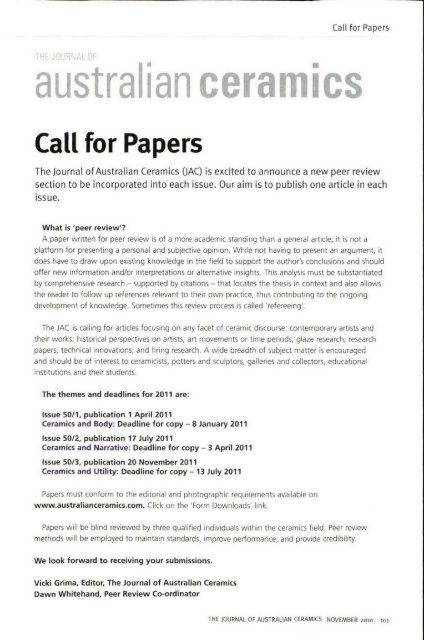The Journal of Australian Ceramics Vol 49 No 3 November 2010
You also want an ePaper? Increase the reach of your titles
YUMPU automatically turns print PDFs into web optimized ePapers that Google loves.
Well Read<br />
article by Peascod is included alongside, describing the experimentation, research and historical material<br />
gathered through international ceramic studio practice and his need for written documentation.<br />
Simone Fraser describes Peascod's development <strong>of</strong> dry glaze through his exploration <strong>of</strong> materials and<br />
techniques and, in particular, his use <strong>of</strong> unpredictable materials where he recognised exquisite aesthetic<br />
results. Fraser also describes how Peascod required the aesthetic to capture the viewer's mind. Alongside<br />
are Peascod's writings about the need for hard work to capture an individual response and to evaluate<br />
ideas after intense studio practice and diverse life experience.<br />
In the next chapter, Owen Rye describes the development <strong>of</strong> spiritual parallels, with alchemiC metallic<br />
surfaces contrasting the plastic nature <strong>of</strong> clay. Peascod 's writing indicates his belief that thought process<br />
and imagination was as important as developing technical expertise.<br />
Lindsay Duncan describes the development <strong>of</strong> Peascod's figurative forms and how this need to<br />
produce raw and satirical portraits became a powerful vehicle for<br />
his figurative sculptures. Peascod's accompanying text comments<br />
on the future direction <strong>of</strong> art activity whilst describing his<br />
experiences in tertiary education.<br />
Chester Nealie writes about Peascod constantly drawing new<br />
ideas and concepts to produce harmonious form and decoration<br />
and about his use <strong>of</strong> unique ceramic construction techniques.<br />
Peascod's drawings were enhanced by his experimentation with<br />
kilns and reduction firing which challenged his artistic practice.<br />
Peascod describes the importance <strong>of</strong> el Sadr addressing the need<br />
for historical references. He also discusses lustreware shard samples<br />
from Fostat.<br />
Ettore A. Sannipoli writes about storytelling as an integral part<br />
<strong>of</strong> maiolica production, while Peascod describes the inspiration he<br />
received from Islamic art and his method <strong>of</strong> working through the<br />
subconscious process.<br />
<strong>The</strong> Afterword by Peter Haynes and Acclamation by Robert Bell,<br />
give further insight into the life and works <strong>of</strong> Peascod .<br />
In Alan Peascod: Artist <strong>of</strong> Exceptional Talent we can read<br />
how Peascod embraced the challenge <strong>of</strong> related technology and<br />
how he was not just a technician but had an appreciation <strong>of</strong> art<br />
history and a passion for making a personal contribution to the<br />
human spirit. Peascod had a vision, involving himself w ith radical<br />
challenges, constantly tackling technical and aesthetic ideas<br />
and expanding the network <strong>of</strong> contacts which has led to the<br />
international awareness <strong>of</strong> <strong>Australian</strong> ceramics. <strong>The</strong> tone <strong>of</strong> the<br />
book conveys Alan Peascod as a much loved and greatly respected<br />
artist who is now sadly missed by many who knew him and had<br />
the pleasure <strong>of</strong> working with him.<br />
Review by Amanda Hawthorn<br />
THE IOURNAL OF AUSTRALIAN CERAMICS NOVEMBER <strong>2010</strong> 99


















